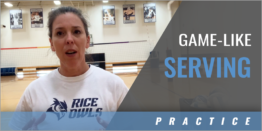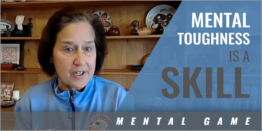|
By: Brian Gimmillaro - Long Beach State University The purpose of this article is to help coaches, players, and parents understand how to be more successful in their volleyball goals. As I observe matches throughout the country at all levels, I see patterns developing with players that take away from their desired outcome. To be specific, I watch players using the 6 technical skills either ineffectively or with less than desired efficiency. Here we will take a look at each of the 6 skills and give you some ideas of how to improve. First of all, let's look at underhand passing. Angles never change! Once the platform is angled at the desired location, it never needs to change. I like to teach the idea of keeping your hips at the server and your platform at the target no matter where the server is standing. Practice this without ever turning your hips. This will mean you will have to develop footwork that moves in all directions without turning sideways. This will also require shuttling in all direction except when you have to run. Another thing I notice is the relationship between the shoulders, knees and feet changes as the ball is served. Remember keep the knees in front of the feet and the shoulders in front of knees at all times. The second skill we will look at is defense. The arm stroke in most cases is too long. The shorter the distance of the stroke the better because the ball comes to fast. Secondly, only lose your feet when you have to. Once you are off your feet, you have lost all your strength in your core. This happens all the time. Third, players are almost always too high when the ball is contacted. You cannot get ready after the ball is hit./p Now let's look at spiking. Almost every hitter who hits the ball on their strong hand side is now hitting the ball above their left ear instead of their right shoulder. This makes it very difficult to control the ball. The ball must be in the middle of your hand and above your right shoulder. Practice throwing the ball back and forth and realize the follow through ends up in the middle of your body. This is a natural motion. Be careful not to pull your arm down to your side. This will keep you from rolling your hand around the ball which will improve your control and your power. One of the misused skills in volleyball is blocking. Bigger blockers tend to become targets by reaching or drifting. Smaller blockers always feel as if they have to be higher. First, no matter what technique you use, swing block with your arms or traditional arm blocking, you need to be able to move both feet as close as simultaneously as possible. This means as you move from side to side either by running or shuttling, your body stays in an athletic position (no leaning, no bouncing, and legs are always bent.) Remember, that most balls are spiked very close to the top of the net. So I like the expression that when your hands are above the net, they are over the net. Do not angle your arms up and then over. Simply over. There are so many different types of serves: stationary float serving from any part of the court, running float serve from and direction, and jump serving. It should be noted that it is one time in the match the ball is not moving so the coordination and timing the movement is up to the server. Some quick observations for the float serve are that the step is generally too long. It should be no longer then the length of the arm that holds the ball. The running float serve too often loses athletic position with the body and the jump serve toss and contact are out of rhythm. All players need to be able to set the ball. To give some areas that will improve the setting more quickly are as follows: The arms need to prepare as the ball is in the air. The rhythm of this can be understood by throwing the ball to a player and having them catch it overhand. As the ball is in the air, you will see the arms prepare during the flight of the ball. Secondly, very few people engage their left leg as they set. The feet need to be staggered but the left knee being bent and the foot firmly placed on the floor before contact. Remember to get completely under the ball and coordinate the extension of the legs and arms. This is not meant to be a total approach to setting; in fact we do a four day camp in which we go step by step to be able to progress through the entire skill. The purpose of this was to give you some insight into setting. I hope that these ideas will help you. Given space availability, I had to limit each skill to just a few helpful tips. An hour long breakdown for each of these skills is available on my video series; Brian Gimmillaro's Learn to Play Volleyball Skills DVD
About the Author... Brian Gimmillaro is one of the most successful volleyball coaches in history. He has won 3 National Championships at the Division 1 level including the first undefeated team in college history. He has participated in 8 final fours. 6 times his players have been named the national player of the year. 43 times his players have been named to the All American team and 13 times his players have been named to U.S. Olympic teams; including 2 time gold medalist Misty May. His accolades include being named coach of the year by the Big West Conference, the Western Region, the U.S. Olympic Committee, Volleyball Magazine, and the NCAA. He was also given the award "All Time Great Coach" from USA Volleyball and is a member of the College Coaches Hall of Fame.
|







